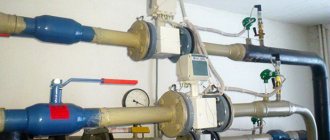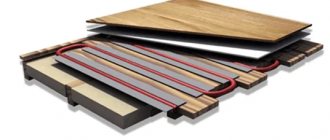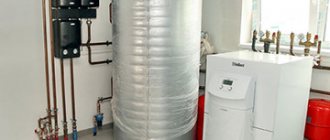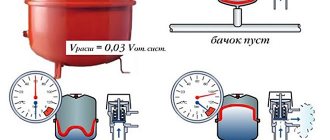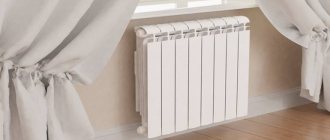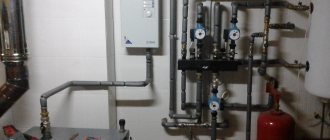Principle of operation
Our Sun emits infrared waves in different spectrums - near, middle and far. Radiation with a wavelength of 8–14 microns is considered the most effective and safe. It is used in the production of equipment for infrared heating at home. Essentially, these heaters are a small sun that runs on electricity. Unlike conventional radiators (oil or electric), they do not heat the air - the radiation only heats the objects it hits, and these same objects become a source of heat. It is from them that the air in the room is heated, so the surfaces in the equipment operating area are always warmer than in other areas of the room.
Operating principle and design of IR heating film
The main element in this design is a carbon coating; modern nanotechnology is used to apply it, allowing printing on a film base. The result is a unique atomic structure in the form of a hexagonal lattice, which is so small that to describe its dimensions it is necessary to use a nanometer scale (this order is expressed in 10-9 m). Thanks to this, the material acquires the ability to emit waves with a length of 5.0-20.0 microns, that is, those in the IR range (not to be confused with ultraviolet and infrared radiation).
Let us recall that the peculiarity of this radiation is that upon contact with matter, wave energy turns into heat. That is why such designs are also called PLEN heaters. This abbreviation stands for as follows:
- P – film.
- L – radial (radiant).
- E – electric.
- H – heating.
Film film can be produced in rolls or mats, their design is presented below.
Design of film electric heaters
Designations:
- A – Carbon (carbon) coating plays the role of the main heating element.
- B – Dense film base.
- C – Silver plating (used as an electrical conductor).
- D – Power bus, made of flexible copper tape.
- E – Film, used as a protective coating.
pros
When compared with traditional heating methods using convectors and oil radiators, the infrared panels in question have a number of advantages:
- Fast heating. When the equipment is turned on, the temperature in the area of its operation rises after 1–2 minutes. This is due to the fact that the rays are not scattered in the air, but reach their direct destination with little loss.
- Quiet operation and environmental friendliness - the operation of the equipment does not produce any sounds or vibrations. During the heating process, no harmful substances are released that could harm residents. Also, film infrared heating dries the air to a lesser extent, since heating occurs not from the hot surfaces of the radiator, but from warm pieces of furniture, walls, and floors.
- Wide application - these systems can be used not only in the home, but also in industrial premises, garages, utility rooms, and on the street.
- Effective air heating. Conventional radiators heat air, which rises, cools and falls down. As a result, the temperature at the feet is always lower than at the ceiling, which is not entirely correct. Infrared heaters direct rays from top to bottom, as a result of which the floor and pieces of furniture below are heated - heat emanates from them, so the air temperature below will be approximately equal to the temperature above. Also, convection currents (air circulation) are noticeably weaker.
- Unlike conventional electric convectors, infrared systems do not burn oxygen and do not dry out the air.
We can talk for a long time about the advantages of these systems.
Infrared heating of a private house: types, pros and cons
It’s hard to imagine a person’s existence in Russia without home heating. Any home user is faced with the question: how to improve the heating complex of a dacha. Everyone knows that heating fuel is constantly becoming more expensive. In any part of our country it is necessary to heat the house during the cold season. The website Sistema-Otopleniya.ru contains many different home heating systems that use exclusively different methods of generating heat. It is recommended to install the listed heating systems hybridly or independently.
Operating principle of infrared heating systems
On the construction market, you can purchase ultra-thin heated floors in the form of mats, as well as floor, wall and ceiling heaters for infrared heating of your home. Their radiation source is carbon-graphite semiconductors, which, when electrical voltage is applied to them, begin to heat up and emit radiation in the long-wave thermal range, similar to that emitted by the rays of the solar spectrum.
The advantage of long-wave infrared radiation is that it does not heat transparent objects and air, but acts directly on the surfaces of furniture, the floor and walls of the room, and the human body. The efficiency of converting electrical energy into heat in this case is about 80%, while for conventional heaters it can be up to 50% or less, because before heating objects, they first heat the air in the room.
Infrared radiation is considered the most comfortable - it is not accompanied by the movement of heated and cooled air masses, and, consequently, by the movement of the smallest dust particles, which are so harmful and dangerous for allergy sufferers. In addition, the rays warm the surface of the skin, accelerating blood circulation, eliminating joint pain and helping with colds. This property of infrared radiation is even used in special saunas. However, it is worth considering underfloor heating and heaters separately.
Infrared heated floors
All of the advantages listed above can most likely be attributed only to infrared heaters, because an infrared heated floor is laid under the floor covering, and it turns out that it directly heats only the glue and the top layer of the covering. In this case, the heat coming from such a floor is no different from the heat that is generated by other types and types of heated floors that have a different principle of operation. The energy consumption of all these heating systems will also be approximately the same. The most economical floors are still water floors, powered by a gas water heater. However, this does not prevent infrared heated floors from having other advantages. To use heated floors more economically, you need to install an automatic thermostat, which will help you use energy more efficiently.
Film infrared flooring has a relatively low cost. Its installation and installation are quite simple, so any more or less trained person can handle them. Its ultra-thin mats can be installed at any angle, allowing you to heat sloped surfaces and even walls. In addition, they are universal and can be installed under any floor covering: carpet, linoleum, parquet, laminate and ceramic tiles.
An infrared floor can be installed in any place where local heating is required - under a mirror in the bathroom or under the bedding on which a pet sleeps. The undoubted advantages include the fact that this type of heated floors is not afraid of mechanical damage, and if any graphite element fails, the load is distributed to the rest, thus the heating efficiency remains the same.
The disadvantages of such a floor include the fact that it cannot be installed under low furniture - beds, chairs, since there is a danger of overheating.
Infrared heaters
These heaters are not yet often found in Russian homes, but judging by forums and reviews on the Internet, the experience of using them is positive and they can successfully replace both oil and convector heating systems. When choosing an infrared heater, keep in mind that its power must correspond to the area of the heated room. For a room of 30 sq.m. you will need a heater with a power of 2.5 kW.
The industry produces ceiling, floor and wall heaters. There are options when the same heater can stand on the floor or be mounted on the wall. You can always choose the optimal installation and fastening method suitable for your premises. But, for example, it is not recommended to install ceiling heaters if the ceiling covering is PVC panels or slabs made of other synthetic materials. There is a danger that when heated they will begin to release harmful substances. In addition, a ceiling heater may not always fit into the interior of the room, especially when it is made in a classic style.
Otherwise, these heaters are really good. Their emitters do not dry the air and there is no specific smell of dust in the room where such a heater operates. In the absence of people, you can turn it off completely, because it warms up the room instantly, there is no need to keep it turned on first. It is more economical in operation and silent. Such heaters are especially effective when installed in places where there are a lot of tiles and ceramic tiles - it is good to install one in the kitchen or bathroom.
You wrote “the pros and cons of infrared heaters,” but did not specify which ones and did not provide a link.
There are also gas infrared lamps used for industrial buildings.
Guys came to our office and promoted this PLEN. A lot of things are written there in the advertisement, especially the “Efficiency =%” smile, and this is presented as uniqueness. Of course, they didn’t know that all electric heaters have such efficiency
I sat down with them and talked about technical topics. They packed up and left.
In general, I have the opinion that if the question is about heating only with electricity, then this PLEN is one of the options along with electric boilers, electric convectors, and electric heated floors. But not more.
My neighbor was tricked on him and treated in such a way that he refused to participate in the construction of the gas pipeline.
rubles per m2 - the cost of this PLEN came out for him. Operating costs are naturally high - heating with electricity is expensive.
And so, as I already said, this is just one of the options for an electric heating device.
IMHO, naturally
We don’t need someone else’s, but we’ll take what’s ours, no matter who it is.
Better late than never. He laid his head on the rails and looked after the departing train.
Contents: [hide]
Infrared heaters, general information
Definition: infrared heater &#; a heating device, the operating principle of which is based on the transfer of heat using radiant energy in the infrared spectrum, which is absorbed by the surrounding surfaces of various objects and living beings. It then becomes thermal and heats the surfaces, which in turn heat the air.
The design and main dimensions of an infrared heater.
The effect of the IR heater appears almost immediately after switching on and only in those areas where it is installed.
Content:
In Russian conditions, with winter temperatures often below minus 30 degrees, an efficient and economical heating system is the most important component of home comfort.
And if residents of megacities do not have much choice, since every high-rise building has a centralized heating system. Then cottage owners have greater freedom of choice.
Infrared heating in private homes is becoming increasingly popular among homeowners. This is due to many advantages over other heating options, but the main ones are the opportunity to significantly save on electricity bills and uniform heating of heated rooms. However, such home heating has several varieties, each with its own characteristics.
Options for infrared heating
Unlike traditional heating using water as a coolant, IR heating is based on the principle of heating not the air in the room, but the objects inside and its walls and floor. Which then release the accumulated heat, and thereby create a comfortable temperature balance.
The entire variety of infrared heating systems can be divided into:
- wall;
- floor;
- and the most common ceiling ones.
Wall systems
Thin IR panels are an excellent alternative to traditional water radiators. A large number of standard sizes allows you to choose a heating panel for any interior that will fit perfectly into it. And the ease of installation makes it possible to independently create an effective heating system.
IR wall heaters are sold as:
ordinary wall panels that can be installed in a window sill niche instead of a conventional radiator;
- designer panels in a variety of colors and sizes;
- plinth strips, adapted for installation around the perimeter of the room in place of standard plinths;
- wall film is a universal solution for installation inside walls, which is best used when installing on walls facing the outside that are prone to freezing and mold.
When choosing the option in the form of a film, you should definitely use a shielding lining, an additional film that minimizes heat loss.
Floor systems
They are film mats with heating elements sealed inside. Due to its small thickness, this version of infrared heating at home is often installed under the finishing coating on the floor. Which can be either tiles or laminate, or linoleum with carpet.
In terms of heat transfer coefficient, the highest efficiency is shown by the IR floor covering for ceramic tiles, followed by laminate. But carpet with linoleum, although slightly, screens infrared waves, thereby reducing the efficiency of the IR heater and increasing energy consumption.
Please note – it is not recommended to install infrared floor film in places where furniture will be placed. This will only lead to a decrease in heat transfer and cause wood furniture to dry out.
Ceiling systems
The most widespread are IR heaters suspended from the ceiling. The energy flow from them goes down, uniformly heating the floor surface.
Most often, this is a design made of a heating element and an aluminum plate to reflect electromagnetic waves. The power of the heating element, and as a result the efficiency of the entire heater, directly depends on the material used in it. Heating elements are produced in ceramic, quartz or tungsten.
Ceiling IR heating devices are used both as the main source of heat and as an addition to other types of heating systems. An infrared heater suspended from the ceiling can be used to zone a room, to create islands of heat in places for relaxation or work.
When using infrared heating at home, you should ensure that the IR device is not pointed towards the heads of the people in the room. Also, such a heater is not recommended for mounting on suspended PVC ceilings, or for placement below one and a half meters above the floor.
All IR heaters come with built-in temperature sensors. Which will turn off the heating elements after reaching the specified temperatures. And they will independently turn on the infrared heating system of the house when the temperature drops below the prescribed values. This allows you to save a lot of energy.
Pros and cons of using it in a cottage
Advantages:
- the infrared heating system does not burn oxygen in the room and does not dry out the air in it;
- infrared devices can be used zonally, as a complement to the main heating system and as the main heat source;
- heating of the room begins immediately upon switching on - there is no need to wait for the coolant to heat up, as in a water system;
- a variety of films and panels allow installation in any room, harmoniously fitting IR devices into any interior;
ease of installation allows you to do all the work yourself;
- low power consumption - about 50 W/h per square meter;
- modularity of the IR system, allowing it to continue to be used even if individual infrared elements fail.
- electromagnetic radiation, which does not always have a positive effect on the human body;
- static electricity that accumulates on the surfaces of IR devices and contributes to the attraction of dust;
- significant capital investments - although the use of IR equipment is economically justified, it will take many years to pay off.
Flaws:
conclusions
Having considered infrared heating of a private house as a heating system for a cottage, the pros and cons of which largely compensate for each other, we can summarize - IR heating of a private house is at least a profitable and quickly installed addition to the main heating system.
It can also act as the main source of heat in a private country home.
See also:
07 June
Versatility, health benefits, safety
Nobody bothers you to combine infrared heating batteries with conventional radiators - they can complement each other. With minimal effort, you can create a “warm island” in your home by installing 2-3 simple heaters, which will be directed to the kitchen corner, for example, or to the sofa. They are often installed in gazebos on the streets or in verandas. This will allow you to sit outdoors even in relatively cold weather.
Installation of infrared heaters is extremely simple - they can be placed on a special leg, hung on a wall or attached to the ceiling. They plug into an outlet and are immediately ready to use.
It is believed that infrared heating systems are more beneficial for human health. The sun's rays, when they hit a person's skin, penetrate inside and heat the blood vessels, causing heat to quickly spread throughout the body. However, there are often disputes that infrared heaters are harmful to health, which is not true. According to research by Japanese scientists, these devices serve as a preventive measure against many diseases.
Minuses
This equipment has not only positive qualities. There are also disadvantages:
- Spot action of the heater. If it works in one place, then the heat will be there; in other parts of the room the temperature is lower.
- Taking into account the fact that the rays of the heater pass through the air and warm the furniture and things that they fall on, it is possible that a plastic smell may appear. This is possible if the heater is directed at the chair on which the TV remote control is lying.
- Aesthetics suffer in some cases. Portable or even film heaters do not always fit aesthetically into the interior.
- High price of the equipment itself.
Considering how much an infrared heater consumes (depending on the power, consumption reaches 0.5–1.5 kWh or 50–200 Wh/m²), it cannot be called energy efficient. In terms of energy consumption, these devices are almost no different from conventional oil radiators or convectors. Efficiency can be achieved by insulating the room and installing heat-reflecting screens, but this is also possible with conventional radiators.
Features of installing a film IR heating system
The manufacturer assures that its products will function rationally, economically and efficiently. But it is important to understand that this only works under specific conditions. If the building lacks insulation, then you should not expect stunning results from the heating system with PLEN films. What requirements must be met to get good results from infrared heating?
We recommend: How to calculate infrared heating?
One of the main ones is complete thermal insulation of walls, doors, and windows in the building. As for the thermal insulation of walls, there are some features. Wall insulation should be done from the outside of the house. For this, different materials can be used: sandwich panels, thermal insulation + plaster. If you insulate the walls from the inside, then infrared heating will be useless.
Walls equipped with thermal insulation will not work harmoniously with the heating system and give off heat, since the insulator will resist this in every possible way. To install a productive heating system, you do not need to completely cover the floor or cover the ceiling with IR film. If you plan to do the main heating, then it is better to cover up to 80% of the floor or ceiling area. If additional, it is enough to cover 30% of the area. The main thing is to correctly calculate the height of the thermostat mounting.
Installation of a film IR heater
If it is a ceiling, then the installation of the film should be at a height of 1.6 m from the floor distance. If it is a floor, then the film should be 15 cm higher. If you make a mistake in calculating the mounting height of the device, the equipment will not function correctly. Another important point is the supply of current power for the integrated operation of the system. It is important to do this, otherwise the profitability of PLEN will decrease. To solve this problem, installing load distribution units is suitable. The device helps turn on different circuits of heating systems, increasing the power indicator.
The film heater must be installed on a special substrate. It has reflective characteristics and will not allow the base on which the film lies to absorb infrared radiation. It goes in the opposite direction, allowing you to get the most productive operation of the device. Without this substrate, half of the IR waves are absorbed by the base, which will lead to significant energy consumption.
Another key point is the height of the room that is planned to be heated, provided that the system is mounted on the ceiling. Basic models of film emitters are designed so that the infrared wave will travel a distance of no more than 3.5 cm. If it is greater, then the radiation does not reach the desired field. And then the system will not function correctly. If the room has high ceilings, then you need to choose a floor-mounted installation method or buy powerful non-standard models of IR heaters.
We recommend: Features of industrial infrared heating
YouTube responded with an error: The request cannot be completed because you have exceeded your quota.
- Related Posts
- Types of infrared heating panels
- Is there any health risk from infrared heating at home?
- Advantages of heating with infrared heaters
- Rules for installing infrared floor heating
- How to calculate infrared heating?
- How to organize infrared heating at home?
Varieties
There are three types of infrared heaters: film, panel, stationary. There are design features between them. Stationary ones are the simplest. These are separate devices that are installed on a leg (or attached to the wall) and plugged into a free outlet. They can be directed to the sofa, and then moved and plugged into another outlet.
Film and panel ones are not mobile. The latter can be installed in the ceiling or on the wall, while film ones can be installed on the ceiling or floor. Each type has its own characteristics.
Panel
When organizing infrared heating of a private house or apartment, panels are more often used, and films are less often used. Flat panel equipment allows you to save room space, as it does not involve changing the height of the room. This is a relevant solution for rooms with low walls.
They consist of:
- Heating element - heating element. It is made from one of three materials: quartz, ceramics, tungsten.
- A special panel that receives heat and transfers it to objects in the room.
- Insulation on the back side. It reflects heat waves from the back of the device and eliminates heat loss.
- Cases.
Infrared panels can be built into the ceiling or hung. Built-in ones are more popular and aesthetically pleasing. In this case we are talking about infrared plasterboard heating with special thermal insulation and graphite thread. They are also built into the walls around the perimeter of the room. Each panel has an average power of 150–200 W.
Film
This type of heater is ideal for organizing a warm corner somewhere on a loggia or veranda. It is used for zonal heating, although no one bothers to cover the apartment with “warm films” over the entire area.
In film infrared heating, the main material is a thin layer of graphite, which is applied to a thermoplastic film. Instead of graphite, a carbon thread can be used - when heated, it creates a heat flow. Note that film heaters create a single integral system, but it consists of separate modules. If some section fails, it is not difficult to replace it with a new one without compromising its integrity.
These panels do not have high power, so their efficiency is low. For this reason, they are used for local heating and are rarely installed along the entire perimeter of the apartment.
IR home heating – what is it?
Heating your home with infrared heating is a practical option, however, it is a rather complicated process. The operating principle of such heating is based on special heating elements, which, emitting infrared rays, heat the objects and surfaces they affect, for example, furniture, floors, walls. Once they heat up, they begin to give off heat. The most appropriate comparison for this heating method is the light that the sun emits. This technology is unique of its kind. The air does not take away heat from a device that gives off heat. Thus, during heating, heat loss is minimal. This energy reaches objects, as well as people, who are in the area of action without any difficulty.
Ceiling installation
Infrared heating does not allow irrational temperature distribution. At the moment when heated air rises, cold air falls down. This happens because objects and hard surfaces heat up, and not the air itself. Accordingly, the temperature of the ceiling and floor is equalized, and the air itself does not overheat. This allows you to save up to seventy percent energy. Moreover, infrared heating can have not only spot heating, but also zonal heating.
Film on the ceiling
Because of this, there are differences in its installation, for example, on the ceiling or on the floor. As for installing infrared heating on the ceiling, they are installed on average at a height of 2.2 to 3.5 meters from the floor. This indicator will be directly affected by the height of the ceilings in a particular room. It is not recommended to point this device directly at a person’s permanent location, namely the head. For example, if the heating is above the bed, then the heat should be directed to the legs or torso. It is not recommended to install infrared heating above window openings. In these places, the heat will simply dissipate, and accordingly, it will not reach its destination. If the ceiling is made of PVC panels, then the use of this type of heating is prohibited.
Infrared heated floor
If IR elements are used to install heated floors, then such heating can be combined with a variety of types of coating, for example:
- ceramic tiles,
- stone and composite materials,
- parquet board,
- laminate,
- carpet
Danger of use and harm
People who choose a heating system want to know whether infrared heaters are harmful. If a person falls asleep on the beach, he can “burn” his skin, his temperature will rise, and even a serious burn is possible. The same is true with infrared heaters - if the panel or mobile equipment is directed at the sofa, then dozing on this sofa is dangerous to health (a person may overheat).
The biggest harm of infrared heating is drying out the skin. With prolonged contact of the skin with infrared rays, the moisture on the human body evaporates, and its replenishment is not carried out immediately. In extremely rare cases, this can lead to a burn (sleeping with the heater on), but more often than not, people’s skin simply dries out.
There is also information that infrared waves somehow affect the protein contained in the skin, and with prolonged exposure, such a heater harms the eyes: first of all, the retina suffers, and secondly, the lens. Sometimes the appearance and development of cataracts in people is associated with infrared heating, although all this has not been proven and is hardly true. Such damage can only be caused when the heater power is very high and a person remains under the waves for a long time.
Connection
It’s not hard to figure out how to connect an infrared heater - it operates on a 220-230 V network, so the simplest and most obvious way is to plug it into an outlet. At least, mobile models are connected to sockets.
Panels or film systems are connected to each other in parallel, then connected to the thermostat (control panel), after which the wire (phase, neutral and ground) is pulled directly to the machine located in the distribution panel. This allows you to bypass all the wiring brought into the apartment or house. Most often, a separate automatic machine is installed to heat the apartment, which is triggered when there is a heavy load or a short circuit. The rest of the wiring in the apartment is connected to another machine. This allows you to correctly distribute the loads generated during the operation of infrared heaters. If you “hang” a powerful heating system on the existing apartment wiring, then when the heating system and, for example, an electric oven, air conditioner or iron are operating simultaneously, overloads are possible. In rare cases, this leads to a fire, although most often automatic devices are triggered.
However, to create a cozy warm corner with a small number of panels with a total power of up to 2 kW, it is possible to connect an infrared heater to an outlet, that is, the general electrical wiring in the house.
Cons of infrared heaters
Unfortunately, infrared heaters still always emit that menacing orange-red glow! And most importantly, zone heating is not suitable for everyone. Admittedly, such a heating system may be far from ideal. A limited heat zone is not suitable if you change locations frequently.
Radiant heat has the characteristics of linear propagation, so a group of people cannot use the same heater at the same time. There are quite powerful models that can heat the entire room, but their operation is more efficient if a person is located directly on the radiation line.
Infrared heating of a private home begins to warm immediately after switching on. The other side of the coin is that they stop generating heat immediately after switching off. Since the air in the room is not actually involved in heating, the room cools down in a matter of minutes. At the same time, the oil-filled radiator will continue to give off heat even when turned off - the heated oil will take time to cool completely.
Electricity consumption when operating infrared heating is undoubtedly less than oil heaters, so the system can be called economical. The energy efficiency of the equipment is more pronounced if the task is not to heat the entire house for an extended period.
Best models
Various manufacturers in Europe and Russia produce home heating equipment. In this rating of infrared heaters, the best models that have collected positive customer reviews are selected.
1st place - Ballu BIH-AP4-0.8-W
The cost of this model is around 3000 rubles. This heater is designed to heat an area of 16 square meters, connects to a 220/230 V system and is installed at a recommended height of 2.4–3.5 meters, its power is 800 W.
Based on reviews, we find out that this is an effective and high-quality model that warms up the room quickly enough. The set includes durable brackets - with their help the device can be rotated. This model is mainly used as an additional source of heating in any room, but is also suitable for a garage and for installation outdoors - the waterproof housing will not allow rain to spoil it.
2nd place - Almac IK5
This infrared heating battery has a lower power of 500 W. It effectively heats 10 square meters, so in a single copy it is used as an additional heat source. However, three similar models can easily cope with heating a large living room or hall.
Judging by the reviews, the device effectively copes with its task, is easily attached to the wall or suspended from the ceiling, and is simply adjustable - it is enough to set 23 degrees during the day, 20 at night. The only drawback is the complexity of the connection. And although the instructions indicate how to install an infrared heater, the kit does not include wires and a thermostat, so without the appropriate knowledge and experience you cannot connect it - you will have to call a specialist, but you can turn a blind eye to this, given the low price of around 2,500 rubles.
3rd place - Peony Thermo Glass P-10 (7000 rubles)
The model is from the Russian one, which has become popular on the Russian market. Power – 1000 W, heating area – 20 m². The device is connected via a regular 220/230 V socket and is equipped with electronic control and a thermostat, which allows you to accurately regulate the power and heating temperature. It also received protection against overheating, which ensures minimal safety and increases its service life. The infrared heater can be installed on the ceiling at a height of 2.3–3.5 meters.
According to reviews, the model is effective: it quickly heats surrounding objects, operates silently and provides soft and pleasant warmth. This is an advantage, since some models heat aggressively.
The disadvantage is the equipment and high price. The model is significantly more expensive than similar heaters, and the kit does not include any cables. The device also needs to be looked after - if you do not systematically wipe the dust off it, then over time a burning smell will appear.
There are also many low-quality products on the market with the CE mark. In one case it means “Conformite Europeenne”, in the other it means “China Export”. Try to choose reliable equipment, since heating devices in the house always pose a certain danger.





